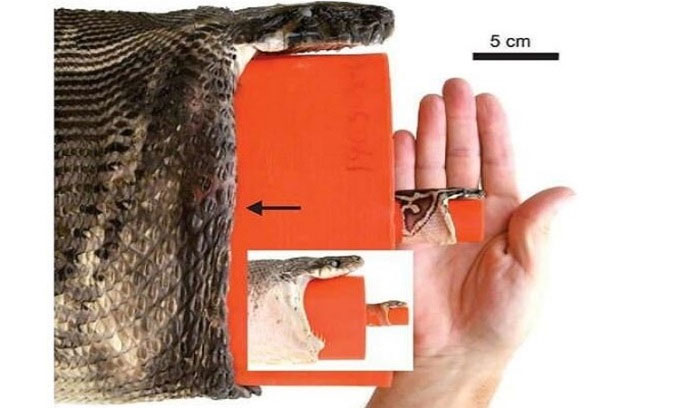The Burmese python measures over 5.5 meters in length and weighs 90 kg, yet it can swallow large prey such as deer and crocodiles thanks to the unique structure of its lower jaw skin.
Researchers at the University of Cincinnati discovered that it is not just the size of the head and body that determines the prey of the Burmese python. Due to the highly elastic skin on its lower jaw, these pythons can consume prey that is six times larger than what other pythons of similar size can handle. The research team published their findings on August 25 in the journal Integrative Organismal Biology.

The research team measures the jaw opening of the Burmese python (large image) and the brown tree snake (small image). (Photo: Integrative Organismal Biology)
Since most pythons swallow their prey whole, they need a wide mouth to accommodate their meals. Unlike the human jawbone, the lower jaw of the python is not fused, allowing for a wide opening. However, Professor Bruce Jayne from the College of Arts and Sciences at the University of California noted that the Burmese python’s remarkable elasticity in the skin of its lower jaw enables it to digest animals even larger than the usual limits for pythons.
The Burmese python is a constrictor. It bites its prey and quickly squeezes to cut off vital blood vessels before swallowing its meal whole. The larger the prey, the more energy the Burmese python gains from the meal. For the Burmese python, this means it does not have to hunt frequently, reducing the risk of crossing busy roads and encountering dangerous predators.
In addition to examining pythons and snakes, Jayne also measured the size and weight of potential prey. This allowed Jayne to use the size of the Burmese python to predict the maximum size of prey and the relative benefits of consuming various animals such as alligators, chickens, rats, or deer. Young pythons have the advantage of a more diverse range of prey compared to similarly sized snakes. Their large size also helps them avoid becoming prey for wading birds, weasels, bobcats, and alligators.
Similar to the brown tree snake, which preys primarily on birds on the island of Guam, the Burmese python is wreaking havoc on the ecosystem in the Everglades National Park. Co-author of the study Ian Bartoszek is a project manager for environmental science at the South Florida Conservation Area. There, he oversees a project to track pythons by implanting radio transmitters in male pythons during mating season and following them to locate females before they lay eggs. Researchers often find deer hooves and the remains of other large animals in their stomachs. Bartoszek once photographed a python regurgitating the remains of an adult white-tailed deer. A nearly mature python can swallow a fawn weighing up to 60% of its total body weight.
By determining the prey limits that the Burmese python can consume, biologists hope to understand how they impact the food chain.


















































